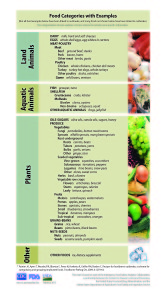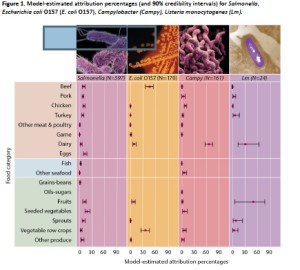Sometimes it’s best to let things ruminate, ferment, instead of simply repeating public relations drivel.
 Guess that’s one reason people write books. Or journal articles.
Guess that’s one reason people write books. Or journal articles.
Various U.S. government agencies patted themselves on the back for their “improved method for analyzing outbreak data to determine which foods are responsible for illness” while underselling the actual report.

The U.S. Food and Drug Administration (FDA), the Centers for Disease Control and Prevention (CDC) and the USDA’s Food Safety and Inspection Service (FSIS) co-authored a report (and threesomes never work out well), Foodborne Illness Source Attribution Estimates for Salmonella, Escherichia coli O157 (E. coli O157), Listeria monocytogenes (Lm), and Campylobacter using Outbreak Surveillance Data by the Interagency Food Safety Analytics Collaboration (IFSAC). A partnership of the three agencies, IFSAC focuses on foodborne illness source attribution, which is the process of estimating the most common food sources responsible for specific foodborne illnesses.
The report briefly summarizes IFSAC’s methods and results, including estimated attribution percentages for the four pathogens named in its title. CDC estimates that, together, these four pathogens cause 1.9 million cases of foodborne illness in the United States each year.
The agencies anticipate that IFSAC’s work will enhance their efforts to prevent foodborne illness.
Who doesn’t anticipate what threesomes will bring.
 The new estimates, combined with other data, may shape agency priorities and support the development of regulations and performance standards and measures, among other activities. The recently developed method employs new food categories that align with those used to regulate food products and emphasizes more recent outbreak data.
The new estimates, combined with other data, may shape agency priorities and support the development of regulations and performance standards and measures, among other activities. The recently developed method employs new food categories that align with those used to regulate food products and emphasizes more recent outbreak data.
As outlined in the report, IFSAC analyzed data from nearly 1,000 outbreaks that occurred from 1998 to 2012 to assess which categories of foods were most responsible for making people sick with Salmonella, E. coli O157, Listeria, and Campylobacter. IFSAC experts divided food into 17 categories for the analysis. The pathogens were chosen because of the frequency or severity of the illnesses they cause, and because targeted interventions can have a significant impact in reducing them.
The report presents the methods behind the results and provides the amount of uncertainty around the estimates.
Some of the findings include:
More than 80 percent of E. coli O157 illnesses were attributed to beef and vegetable row crops, such as leafy vegetables.
Salmonella illnesses were broadly attributed across food commodities, with 77 percent of illnesses related to seeded vegetables (such as tomatoes), eggs, fruits, chicken, beef, sprouts and pork.
Nearly 75 percent of Campylobacter illnesses were attributed to dairy (66 percent) and chicken (8 percent). Most of the dairy outbreaks used in the analysis were related to raw milk or cheese produced from raw milk, such as unpasteurized queso fresco.
More than 80 percent of Listeria illnesses were attributed to fruit (50 percent) and dairy (31 percent). Data were sparse for Listeria, and the estimate for fruit reflects the impact of a single large outbreak linked to cantaloupes in 2011.
The figure on the right (the one other than Bob, Carol, Ted and Alice) is what they sent out to PR types. The figure on the left is what they actually wrote.
